
Madame Poupoule at Her Dressing Table 1898
0:00
0:00
henridetoulouselautrec
Musee Toulouse-Lautrec, Albi, France
Dimensions: 60.8 x 49.6 cm
Copyright: Public domain
Curator: Henri de Toulouse-Lautrec's "Madame Poupoule at Her Dressing Table," created in 1898, offers an intimate view of a woman's toilette. It’s currently housed at the Musée Toulouse-Lautrec in Albi, France. Editor: My first impression is one of introspection. The sitter seems shielded by her hair, almost hidden. It's very atmospheric, the tones quite muted, creating a sense of privacy. Curator: Indeed. The brushwork here is rapid, characteristic of his impressionistic style, but grounded by a stark sense of realism. Look closely at the various unguents and cosmetic items on the table: small signifiers of an entire world of grooming rituals and commodity. He has skillfully built texture to reflect the surfaces involved. Editor: The unguents and powders act as both stage dressing and symbolic props. Dressing tables often represent vanity, of course. But beyond that, I'm curious about this act of preparation. Is she creating an illusion, hiding her true self behind layers, or armoring herself for the day? Hair partially concealing her face feels quite loaded, it's like a curtain veiling one’s true character from the outside world. Curator: Precisely. There’s a tangible contrast between the woman's unadorned state and the artifice she’s about to create. Lautrec often depicted the lives of performers and marginalized figures, bringing attention to those often excluded from the canon. The materials, from paint to powders, contribute to a discussion of constructing identity within a commercial system, selling an image of one’s self to the masses. Editor: And think of all the gazes involved, the unseen observers of this intensely private moment, not least the artist’s own and now, ours. I notice she’s facing slightly away, preventing us from seeing her entire face and the very art of make-up; the performance isn't complete, not ready for unveiling. The mirror reflection further complicates this relationship of inner versus outer self, real versus perceived self. Curator: It prompts questions about who constructs that gaze. Is it societal expectations? The burgeoning mass media of the time pushing an ever increasing pressure to perform identity on stage or on camera? Lautrec understood those questions implicitly through the simple choice of depicting the process. Editor: I appreciate the intimate portrayal and psychological depths captured. It speaks volumes about identity, both revealed and concealed. Curator: Agreed, seeing how the social is made tangible via objects always sheds some new light.
Comments
No comments
Be the first to comment and join the conversation on the ultimate creative platform.













